Taking great care of pet rats can be amazingly satisfying and rewarding. Here are five of the top things I’ve found that’ve helped me get closer to my rats and promote pet rat health and happiness:
1. Diet
Feeding your rats a high-quality diet is one of the most important things you can do for your rats’ health.
The four most widely respected rat diets are made by Oxbow, Harlan Teklad, Mazuri and Science Select. Protein needs decrease the older a rat gets. Mazuri has the highest protein of the three (23%) making it less desirable for older adults but great for babies. Oxbow and Harlan Teklad both have different formulas to match your rats’ life stage and nutritional needs. Oxbow is the easiest to find since there are some pet stores that carry this diet. However, all these diets can be ordered online. Here are reliable sources from which to order Oxbow, Harlan Teklad and Mazuri.
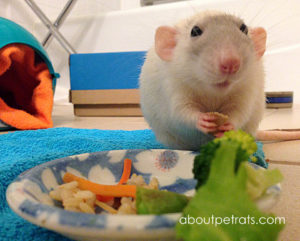
In addition to a quality commercial diet, feed your rats organic vegetables and fruits. Bok choy, kale and broccoli are especially good veggies to feed. Before I started researching the best diets for my rats, I’d never even heard of bok choy! Learning about their optimum diet helped me eat better, too.
For female rats, some feel that soy can help reduce the occurrence of mammary tumors. I concur with this thought. All the commercial diets above contain some soy (to varying degrees). You can also simply add tofu, soybeans and miso to female rats’ diets.
I am a huge fan of Green Mush. Ever since I started feeding my rats Green Mush, my rats have lived almost twice as long as they had before I gave my rats Green Mush.
An EPA DHA (fish oil) supplement can also be helpful. with your vet for the proper dosage for your rats.)
Information on other supplements can be found on my Pet Rat Supplements page.
Learn which foods are dangerous for pet rats.
2. Environment
Make sure your rats have a large enough cage.
Diligently clean and disinfect their cage weekly and spot clean daily.

Choose the best location for your rats’ cage
Place their cage in a place where you spend a lot of time and in a place that isn’t overly noisy.
If you have other pets such as cats and dogs living in your household, make sure your rats are in a room that has a door that can be closed.
Keep the room at a comfortable temperature (not too hot or cold) and allow for adequate air flow (neither stagnant nor drafty).
Save your scents for when you’re in another area of the house, or when you’re not at home
Do not use scented products in the room where your rats are housed. This includes scented candles, incense and air fresheners. If your bathroom is adjacent, be mindful of using aromatic shampoos and body wash. If you must use fragranced body products, close the bathroom door while showering or bathing. Keep the door closed until the scent dissipates. It’s healthiest, however, to use unscented products.
Enrichment inside and outside their cage increases pet rat health and happiness

Wouldn’t life be dull if you lived in one room, never came out and the furniture was drab and never changed day after day for your entire life? Contrast this with all the varieties of cage and room accessories you can set up for your rats. Inside the cage, choose hammocks, chew toys, ladders, wodent wheels. Create places in which to hide and nest as well as nesting material.
In their free-roam room, make sure it’s safe as well as fun. You can build a maze and offer boxes and paper bags in which to play. Add access to safe places to climb and food to hoard. Play games and teach tricks.
Enrichment is all about engaged interactions—whether it be with you, other rats or with their environment. Make changes regularly so they continually have new things to explore.
3. Veterinary Care
Establish a great relationship with your vet
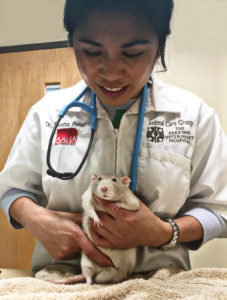
This is an invaluable part of keeping your rat healthy and happy. Think of your vet as being on your team. Since rats are prone to developing so many ailments, it’s crucial to find a vet who’s qualified to care for them and who enjoys doing so. Once you find a great rat veterinarian, you’ll understand how wonderful it is to work with a vet who wants to help you keep your rats as healthy as possible.
Within a week or so after bringing new rats home, an exam by a qualified veterinarian is the best way to establish base-line pet rat health. Even if you think your rat is perfectly healthy, your vet can spot things you may not have noticed. It’s also a fantastic way to establish going to the vet as a routine activity for your rats. Your rats will think it’s normal and won’t be fearful if they’re already used to going to the vet. I take my rats to the vet for an exam at least every six months. When they’re older, I often bring them in more frequently—especially if I observe any symptoms or signs of illness.
It’s good to have a relationship with more than one veterinarian. This can’t be stressed enough. There will always be a time when your rat needs to be seen and your regular vet has a day off or is on vacation.
For optimum pet rat health, know when your rat needs to see a vet
In addition to initial and regular wellness exams, here are symptoms which indicate your rat should be seen by a veterinarian.
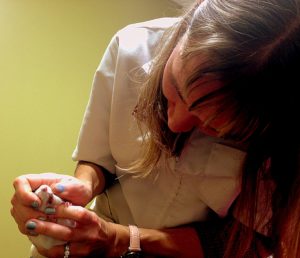 For female rats, spaying prevents them from developing mammary tumors. Mammary tumors are quite common. If you haven’t gotten your rat spayed and she develops a tumor, you can have her spayed at the same time her tumor is removed. Keep in mind, the earlier a rat is spayed the better. (You don’t need to wait until she gets a tumor to have her spayed.)
For female rats, spaying prevents them from developing mammary tumors. Mammary tumors are quite common. If you haven’t gotten your rat spayed and she develops a tumor, you can have her spayed at the same time her tumor is removed. Keep in mind, the earlier a rat is spayed the better. (You don’t need to wait until she gets a tumor to have her spayed.)
These last two items on this top five ways to care for your rats list are ones you’ll develop to fit your and your rats’ unique needs. It’s a creative process…trying out different things, observing, using your intuition combined with common sense, then deciding what feels best for you and your rats.
4. Spending time together promotes pet rat health and happiness
Consistently, spend time daily with your rats. (Preferably at least two times daily.) You’ll be closer and your rats will be much better socialized if you spend adequate time with them.
At first, I found this difficult since I work a full-time job outside of the home, one which doesn’t allow me to bring my rats to work. Then I figured out, it’s simple: There are so many chores and daily rituals around your house which are easy to do with your rats! Here are some examples:
- If you’re someone who puts on makeup in the morning, your rats will enjoy being in the same room as you. For instance, put your make-up on in a rat-proofed bathroom. Sit on the floor if you can. Your rats will love being on your shoulder while you apply make-up. Of course, don’t use any sprays or loose powder around
 your rats. (Powders and sprays can irritate their lungs.)
your rats. (Powders and sprays can irritate their lungs.) - If you have a tub, take a bath while your rats are in the bathroom with you. (Make sure your bathroom is rat-proofed first.) Some rats like sitting on the side of the tub. Some even like to walk up and down your body while you’re in the bath, dipping their toes (and tail) in the water.
- While doing dishes you can have your rats either on your shoulder or out on a countertop adjacent to the sink. I like to place a cat carrier on the countertop next to my kitchen sink. Inside the carrier are paper towels placed in the back to be used as a bathroom. Your rats will have a blast exploring your kitchen countertop while you’re nearby, doing dishes or cooking in the kitchen.
- Read a book, watch a movie, work on your computer while your rats are on your shoulders or inside your shirt.
- They love it when you fold laundry with them. Place a big pile of clean clothes on the floor. Allow them to tunnel in while you fold each item one by one.
- Run errands with your rats when the weather isn’t too cold.
- Take them with you when vacationing (for tips on both running errands and/or vacationing with rats, see On the Road with Rats.)
I just want to make sure you realize you can be with your rats much more than you’d ever think!
5. Attention and Awareness: Get to know your rats as individuals
Every rat is different just as every human is different. Some rats are extra cuddly, some extra active and requiring lots of environmental stimulation. Currently I have two rats. One of them could care less about learning tricks and is unmotivated by treats. She does like to cuddle, though. My other rat loves interacting with me, learning new tricks and hoarding Oxbow kibble by playing a scavenger hunt type of game where she locates kibble throughout their room and brings it back to hide in their cage.
To promote pet rat health and happiness, spend a little one-on-one-time with each rat every day. Whether it be petting, playing or training, it’s important for each rat to have exclusive time with you. That way you’ll get to know what’s normal for each of your rats. This will make it easier not only for you and your rat to become closer, but you’ll also be able to tell more easily when there are changes in behavior which could indicate a health problem. Treat each rat as an individual, letting them know you understand and honor their unique personality.
each rat to have exclusive time with you. That way you’ll get to know what’s normal for each of your rats. This will make it easier not only for you and your rat to become closer, but you’ll also be able to tell more easily when there are changes in behavior which could indicate a health problem. Treat each rat as an individual, letting them know you understand and honor their unique personality.
While petting each rat, you can tell easily if they’ve developed a lump, have a laceration or scabs.
Conclusion
In closing, the journey of nurturing healthy and happy pet rats is a profoundly rewarding one. These remarkable creatures have a way of enriching our lives as much as we enrich theirs. Remember, a balanced diet, a safe and stimulating environment, a trusted partnership with a knowledgeable veterinarian, quality time spent together, and acknowledging the unique personalities of your furry companions are the keys to ensuring their well-being. As you embark on this adventure with your beloved rats, let it be a constant reminder that the love and care you invest in them will be returned tenfold in the form of boundless affection, companionship, and unforgettable moments. Cherish every day with your rat companions, and together, you’ll create a world of pet rat health and happiness that will last a lifetime.
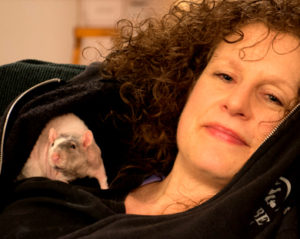 your rats. (Powders and sprays can irritate their lungs.)
your rats. (Powders and sprays can irritate their lungs.)

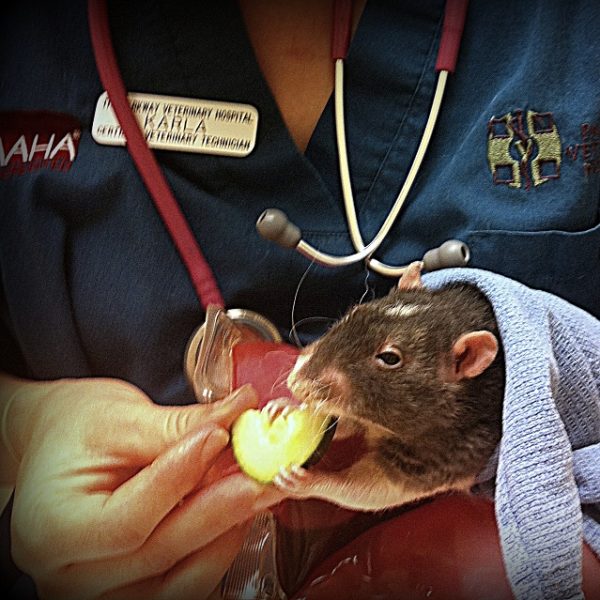
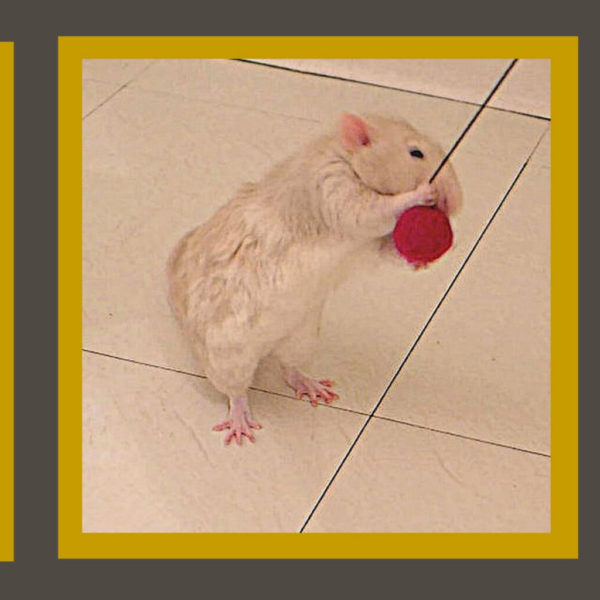



Leave a Reply